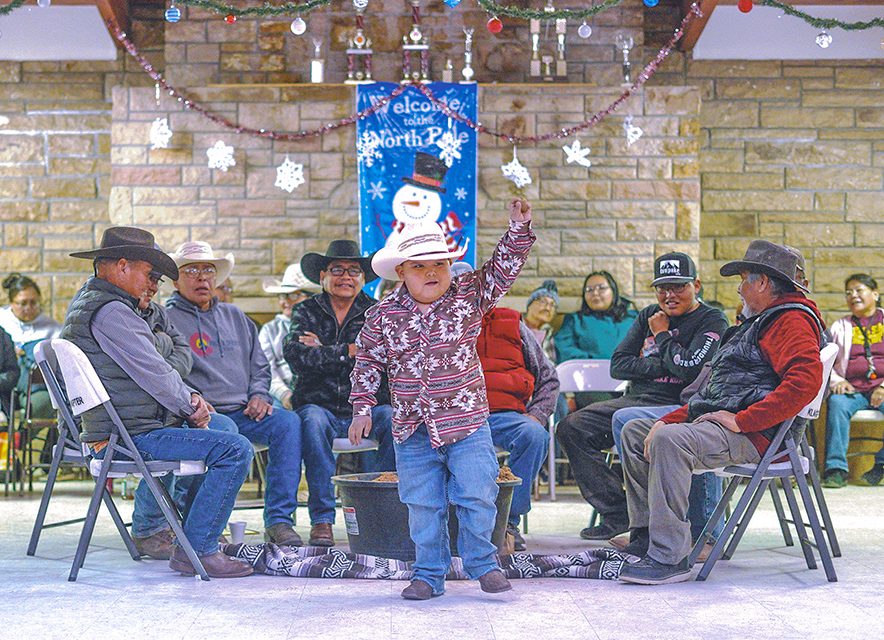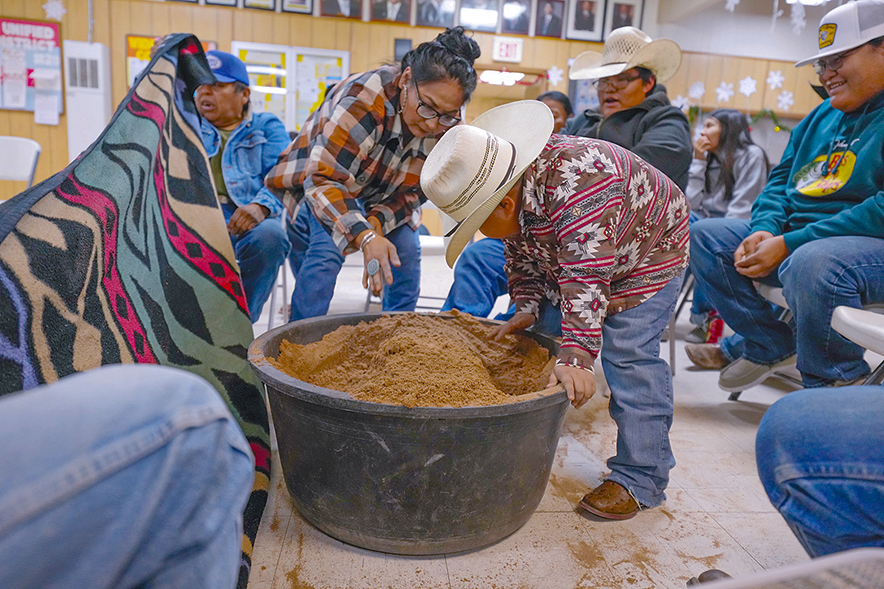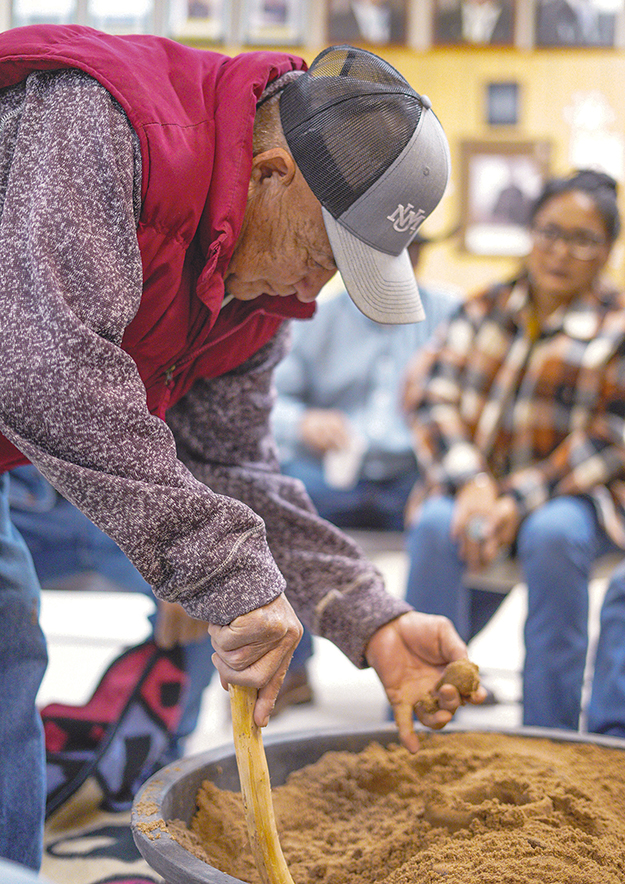
Késhjéé: A tradition of balance and hope in the face of drought

Special to the Times | Donovan Quintero
Davion Chester, 5, from Klagetoh, Ariz., holds up the yucca ball he found hidden in one of the shoes during a Késhjéé’ at Klagetoh Chapter in Klagetoh, Ariz.
KLAGETOH, Ariz.
Davion Chester, 5, from Klagetoh, walked with a purpose to his opponent’s box. His determination to find the hidden gem inside one of four shoes was obvious: he meant to find it.
And when he did find it – several times, in fact – he held his prize in the air, walking back to his side victoriously as he was cheered on.
In Klagetoh, Arizona, the New Year’s Eve air resonated with the rhythmic Navajo Shoe Game, or Késhjéé, chants as players busily sang. At the same time, two team members held a blanket up to prevent their opponents from seeing where they hid a ball made of yucca.

Special to the Times | Donovan Quintero
Davion Chester, 5, from Klagetoh, Ariz., helps hide the yucca ball in one of the shoes during a Késhjéé’ in Klagetoh, Ariz.
Paul Long and Alan Tapahe, keepers of Navajo traditional knowledge, explained the origins of day and night on New Year’s Eve, as well as the complex traditional teaching between myth, tradition, and cultural values.
The game, while on the surface, depicts men, women, and children surrounding a box of dirt with four hidden shoes, singing and playfully attempting to thwart the opponent from finding the ball with deception. The deeper meaning of the game, Tapahe and Long shared, is more than a game – it is a ceremonial ritual rich with spiritual and cultural significance. Késhjéé is a ritual deeply connected to the Navajo worldview, where balance, harmony, and respect for duality are paramount. It teaches values such as endurance, humility, and the importance of collaboration, reflecting the lessons of the creation story. These teachings extend beyond the game, offering a framework for navigating interpersonal relationships and understanding natural cycles.
Késhjéé, a guessing game
According to the traditional knowledge keepers, Késhjéé is a guessing game at its core, but its deeper layers are steeped in cultural significance. Four moccasins represent the world’s elements, with the hidden ball symbolizing the sun. Teams of players – Day People and Night People – take turns hiding the ball while the opposing team attempts to locate it. Victory is determined by points, represented by the 102 yucca sticks, and the game can last for hours, even days.
“The animals gathered with 102 yucca stems to keep score,” Long shared. “Two longer stems, representing the elders, grandma, and grandpa, could change the outcome of the game.”
The ball, originally crafted from yucca, represents a small sun, while the four moccasins – traditionally made from bear hides – connect players to the Earth. Sacred songs accompany the hiding and guessing, imbuing the event with spiritual resonance.
Test of strategy, intuition
The game unfolded under the watchful eyes of animals like the cunning owl and the stubborn badger, shared Long at the Navajo Nation Museum in Window Rock. Each move was a test of strategy and intuition, and the stakes were high. The outcome of the game eventually led to a compromise, forever establishing the cycle of day and night as people know it, he added.
Through the game, Diyin Dine’é address questions about the balance of life, including the balance between day and night, the inevitability of aging, and the existence of good and evil.
At the time, never-ending twilight blanketed the world, which caused a divide among wildlife. Nocturnal beings desired eternal night, while daylight beings preferred unending daylight. This conflict eventually led to the suggestion of a sacred game, proposed by a Yé’iitsoh, to establish the alternating cycles of day and night.
The role of oral storytelling in preserving such cultural narratives is vital. The Navajo tradition emphasizes sharing these stories during the winter months when the Earth rests and introspection is encouraged.
The creation narrative, as well as its accompanying practices like Késhjéé, provides a framework for understanding the world and fostering harmony, said Long.
Tapahe, who is also a Klagetoh grazing official, emphasized the importance of the tradition, especially during times of crisis.
“We’re still waiting,” Tapahe said, referring to the drought that has gripped the region.
He explained that Késhjéé can be used to encourage weather patterns to occur. His hope on New Year’s Eve was that it would bring much-needed moisture to the reservation.
Calling for help from ancestral spirits
This winter, the land has yet to receive the moisture it desperately needs. The game, which uses sacred materials believed to influence natural elements like rain and snow, is a way for the Navajo people to summon help from their ancestral spirits and the natural world, said Tapahe.
“It’s been carried a long time, my grandpa, my grandma,” he said, his voice reverent. “It’s not just a shoe game; there’s a lot of stories to it.”

Special to the Times | Donovan Quintero
Késhjéé’ player Harry Smith grabs the yucca ball after finding it on New Year’s Eve in Klagetoh, Ariz.
The stories Tapahe refers to trace back to the origin of the game itself, an intricate narrative told by Navajo elder Long. Késhjéé, also known as the Moccasin Game, began at the dawn of time when animals – both nocturnal and diurnal – found themselves locked in a dispute over which should dominate the world. This argument between the Night People and the Day People led to a high-stakes game to determine the balance of power.
Each material used in the game is sacred. The bear-hide moccasins connect players to the Earth, the yucca sticks symbolize the passage of time, and the songs sung during the game invoke ancestral spirits. As Tapahe explained, the ritual is a way for the community to engage with the natural world and influence its cycles.
The game’s narrative also features the Giant, a mythical figure representing power and the sun. His failure to triumph due to his hubris and the owl’s cleverness serves as a cautionary tale about the perils of overconfidence and the necessity of balance.
Characters like Coyote add complexity to the story. As a trickster, Coyote shifts allegiances depending on which side is winning, embodying adaptability and the duality of nature. The narrative also features symbolic transformations of animals, such as the crow, whose black feathers are explained as the result of dipping into charcoal during the game, and the bear, whose misshapen feet and brown fur are attributed to sunlight and hurried movement.
Beacon of hope, respect for natural world
These stories teach patience, observation, and respect for the natural world. They are passed down orally, ensuring that each generation of Navajo people understands the values embedded within the game.
The practical purpose of Késhjéé extends beyond storytelling. For the Navajo people, it is a ceremonial act of resilience, especially in the face of challenges like drought. The ongoing lack of moisture in Klagetoh, said Tapahe, is leaving the land and its people vulnerable.
By playing the game, participants not only honor their traditions but also actively seek to influence the environment. The sacred materials used in the game are believed to encourage rain, snow, or wind – forces essential for the region’s survival. The songs and chants, passed down through generations, are prayers for harmony and abundance.
The game also serves as a reminder of the Navajo people’s interconnectedness with nature. The balance achieved through the game mirrors the balance sought in life, where light and dark, day and night, must coexist.
Tapahe’s concerns about the drought echo the broader struggles faced by Indigenous communities as they confront climate change and environmental degradation. For the Navajo, the game is more than a symbolic act; it is a way to reaffirm their relationship with the Earth and call upon the wisdom of their ancestors for guidance.
As Paul Long shared the origin story of the Moccasin Game, his words carried a sense of urgency.
“It’s important to keep the legend alive,” he said. “These stories and games connect us to our roots, to the land, and to each other.”
In Klagetoh, as the community gathered around the fire on New Year’s Eve, the shoe game became a beacon of hope. The chants and laughter echoed across the arid land, carrying with them the prayers of a people determined to maintain their connection to the Earth and their ancestors.
The game embodies the Navajo philosophy of balance and interconnectedness, Tapahe shared. It is a ritual of storytelling, spirituality, and resilience, reminding the Navajo people – and the world – of the delicate harmony that sustains life.
As Alan Tapahe and Paul Long continue to share their knowledge and stories, they ensure that this legacy endures. The game is more than an act of tradition; it is a testament to the enduring strength of the Navajo people and their commitment to preserving their cultural heritage in the face of adversity.
In the stillness of the Klagetoh night, with the stars shimmering above, inside the Klagetoh Chapter House, young Davion Chester helped reaffirm the Navajo people’s place within the great cycles of nature through Késhjéé, helping his people continue to walk the path of balance, guided by the wisdom of his ancestors and the hope for a brighter tomorrow.








 Highway 264,
Highway 264, I-40, WB @ Winslow
I-40, WB @ Winslow